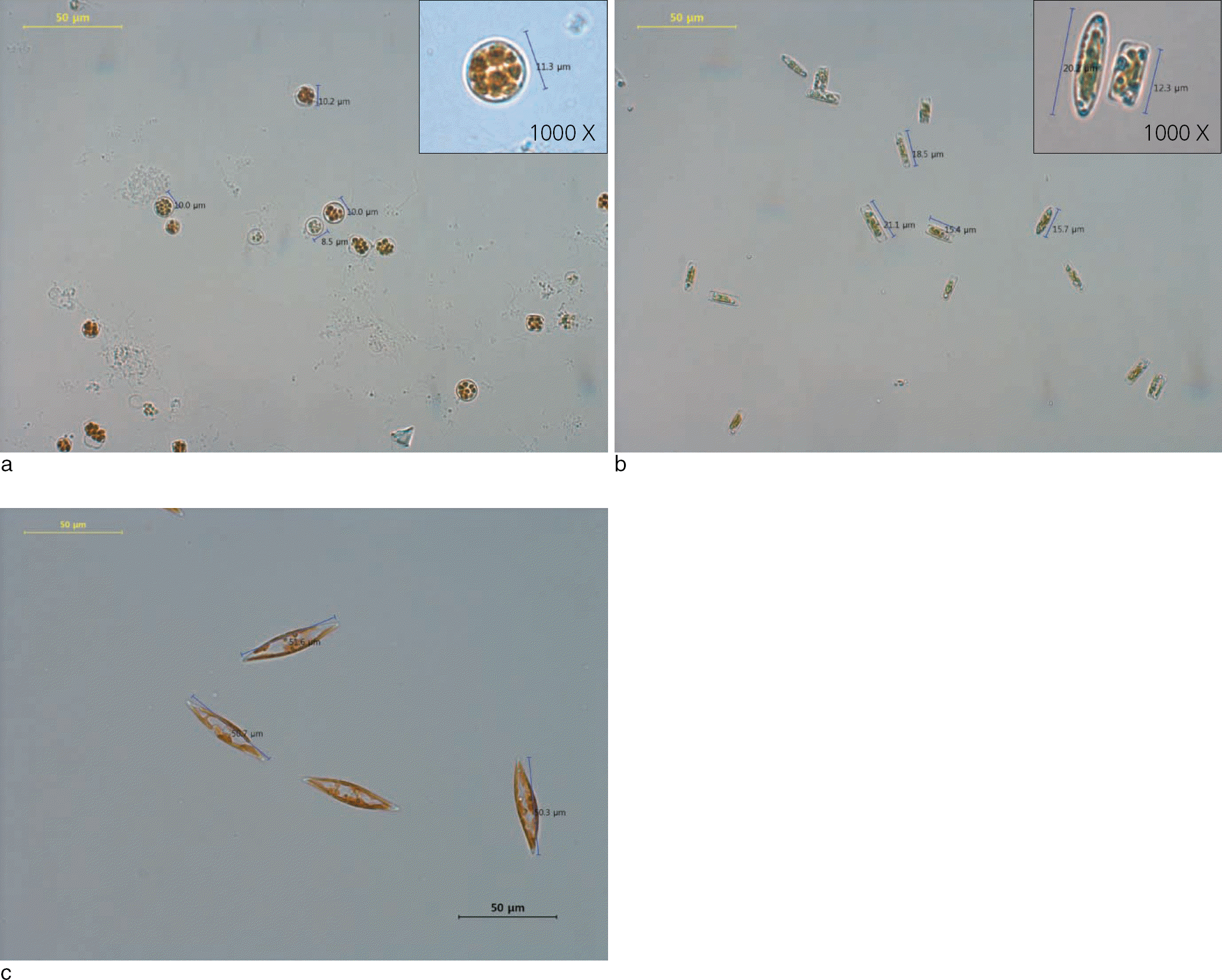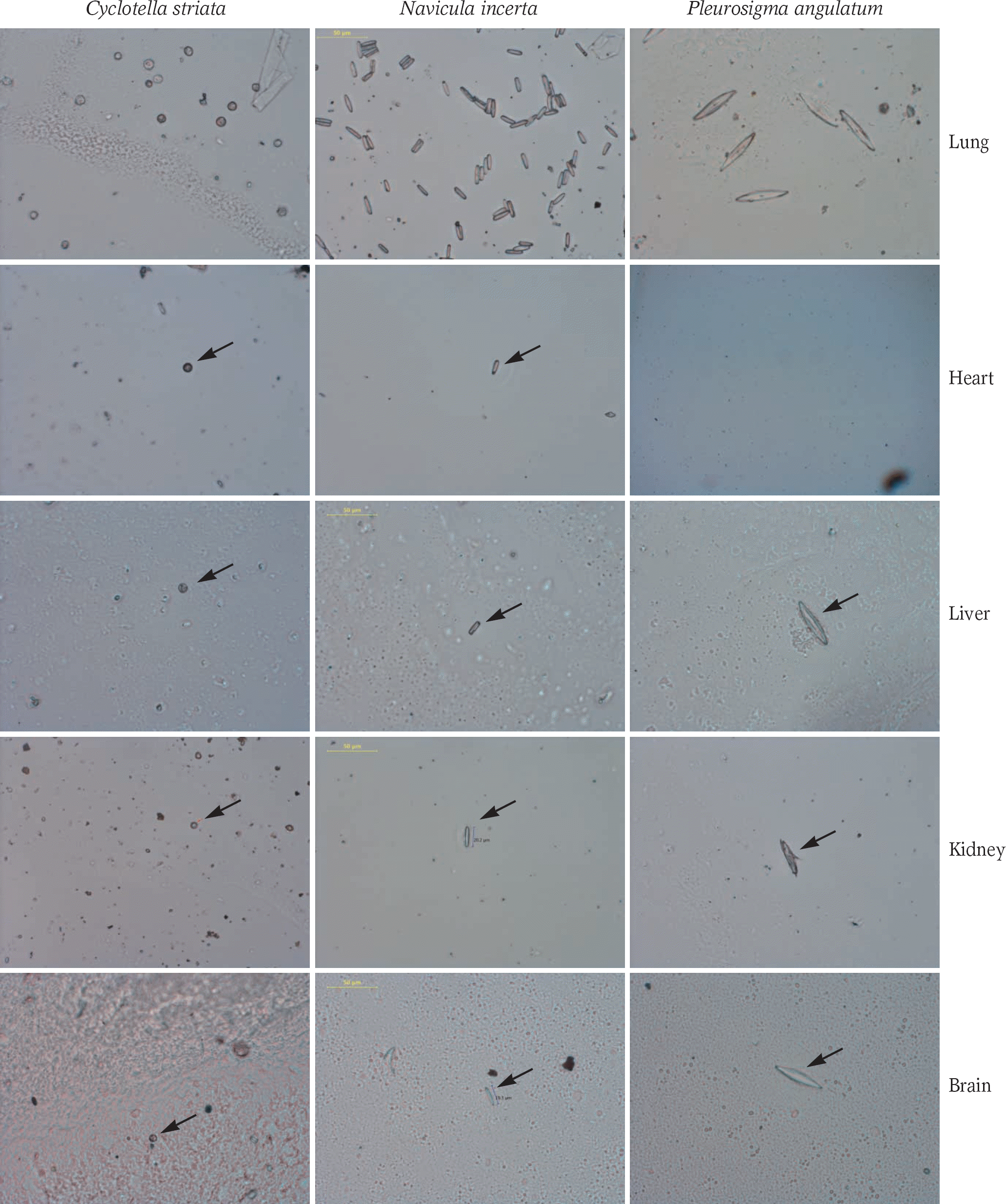Abstract
Drowning is one of the most common causes accidental death worldwide, but its diagnosis remains a challenging task in forensic pathology. Several authors have suggested that diatom analysis be conducted via an enzymatic digestion method that uses proteinase K to provide objective evidence for drowning; we employed this method in our study because of its superior applicability as compared to the conventional disorganization methods. The purpose of this study was to examine the reclaiming ratio of diatoms from experimentally drowned animal organs, which could be influenced by diatom morphology. The authors injected 3 diatoms species (Cyclotella striata, Navicula incerta, and Pleurosigma angulatum) into a rat’ s airway and compared the detection rate to investigate the factors that influence the sensitivity of diatom analysis. The results are as follows: (1) Average reclaiming ratio in the lungs was 81.07 for Navicula incerta, 48.26 for Cyclotella striata, and 5.35 for Pleurosigma angulatum. (2) The detection rates from the closed organs in 15 experimental animals were highest in the kidney (73%, 11/15), followed by the heart (67%, 10/15), brain (60%, 9/15), and liver (53%, 8/15). (3) Two Cyclotella striata was detected in the kidney of postmortem control group which suggest the possibility of contamination during laboratory procedure. In conclusion, the authors propose that diatom size could be a significant influencing factor for diatom extraction from the organs of drowned bodies; therefore, the results of diatom analysis must be interpreted after considering the diatom population of the drowning medium at the scene and the possibility of contamination during the laboratory procedure.
Go to : 
REFERENCES
1. Soar J, Deakin CD, Nolan JP, et al. European Resuscitation Council Guidelines for Resuscitation 2005. Section 7. Cardiac arrest in special circumstances. Resuscitation. 2005; 67Sl:135–70.
2. Zhu BL, Quan L, Li DR, et al. Postmortem lung weight in drownings: a comparison with acute asphyxiation and cardiac death. Leg Med (Tokyo). 2003; 5:20–6.

3. Piette MH, De Letter EA. Drowning: Still a difficult autopsy diagnosis. Forensic Sci Int. 2006; 163:1–9.

4. Ludes B, Coste M, Tracqui A, et al. Continuous river monitoring of the diatoms in the diagnosis of drowning. J Forensic Sci. 1996; 41:425–8.

5. Sidari L, Nunno ND, Costantinides F, et al. Diatom test with Soluene-350 to diagnose drowning in sea water. Forensic Sci Int. 1999; 103:61–5.

6. Lunetta P, Penttila A, Hallfors G. Scanning and transmission electron microscopical evidence of the capacity of diatoms to penetrate the alveolo-capillary barrier in drowning. Int J Legal Med. 1998; 111:229–37.

7. Pollanen MS, Cheung C, Chiasson DA. The diagnostic value of the diatom test for drowning, I. Utility: a retrospective analysis of 771 cases of drowning in Ontario, Canada. J Forensic Sci. 1997; 42:281–5.

8. Woelkerling WJ, Kowal RR, Gough SB. Sedgwick-Rafter cell counts: a procedural analysis. Hydrobiologia. 1976; 48:95–107.

10. Ming M, Meng X, Wang E. Evaluation of four digestive methods for extracting diatoms. Forensic Sci Int. 2007; 170:29–34.

11. Ludes B, Quantin S, Coste M, et al. Application of a simple enzymatic digestion method for diatom detection in the diagnosis of drowning in putrified corpses by diatom analysis. Int J Legal Med. 1994; 107:37–41.

12. Krstic S, Duma A, Janevska B, et al. Diatoms in forensic expertise of drowning - a Macedonian experience. Forensic Sci Int. 2002; 127:198–203.
13. He F, Huang D, Liu L, et al. A novel PCR-DGGE-based method for identifying plankton 16S rDNA for the diagnosis of drowning. Forensic Sci Int. 2008; 176:152–6.

Go to : 
 | Fig. 1.Three species of diatoms used for this experiment are photographed for showing their shape and details (× 400). a: Cyclotella striata; b: Navicula incerta; c: Pleurosigma angulatum
|
 | Fig. 2.Photographs show the diatoms extracted from experimentally drowned rat’ s organs (× 400). |
Table 1.
The Features of Microalgal Species Used for the Study
Table 2.
Total Number of Extracted Diatom Cells in Analyzed Organs of Rats
| No. | Species | Lung | The closed organs | ||||
|---|---|---|---|---|---|---|---|
| Heart | Liver | Kidney | Brain | Total | |||
| 1 | Cyclotella striata | 024,000 | 024 | -† | 036 | 12 | 072 |
| 2 | 028,536 | 030 | 04 | 024 | 24 | 082 | |
| 3 | 020,412 | 030 | - | 060 | 12 | 102 | |
| 4 | 036,000 | 006 | 12 | 024 | 04 | 046 | |
| 5 | 024,000 | 012 | 04 | 072 | 24 | 112 | |
| Subtotal | UC∗ | 102 | 20 | 216 | 76 | 414 | |
| 6 | Navicula incerta | 096,516 | 016 | 08 | 008 | 04 | 036 |
| 7 | 128,232 | 012 | - | 012 | 04 | 028 | |
| 8 | 104,640 | 008 | 08 | 024 | - | 040 | |
| 9 | 095,448 | 008 | 04 | 016 | 04 | 032 | |
| 10 | 098,040 | 004 | 04 | 008 | - | 016 | |
| Subtotal | UC | 048 | 24 | 068 | 12 | 152 | |
| 11 | Pleurosigm angulatum | 001,230 | - | - | - | 04 | 004 |
| 12 | 007,440 | - | 04 | - | - | 004 | |
| 13 | 000,240 | - | - | - | - | 000 | |
| 14 | 003,360 | - | - | 004 | - | 004 | |
| 15 | 001,200 | - | - | - | - | 000 | |
| Subtotal | UC | 000 | 04 | 004 | 04 | 012 | |
| 16 | PM- Cyclotella striata | 024,600 | - | - | 002 | - | 002 |
| 17 | PM- Navicula incerta | 076,104 | - | - | - | - | 000 |
| 18 | PM- Pleurosigma angulatum | 009,600 | - | - | - | - | 000 |
| 19 | Negative control (1) | - | - | - | - | - | 000 |
| 20 | Negative control (2) | - | - | - | - | - | 000 |
| Total | UC | 150 | 48 | 290 | 92 | 580 | |
Table 3.
Reclaming Ratio of Diatoms by Experimental Groups and Organs




 PDF
PDF ePub
ePub Citation
Citation Print
Print


 XML Download
XML Download